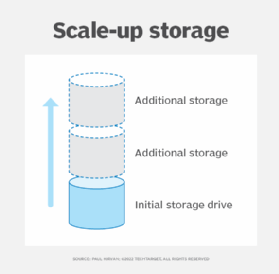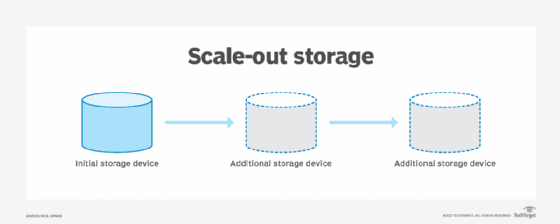
Getty Images
Differences in scale-up vs. scale-out storage
Scaling up and scaling out are both approaches to increase storage capacity. To decide which approach to take, consider short- and long-term requirements.
Organizations that handle rising data volumes will need to scale their storage. Typically, this means organizations will decide between scale-up vs. scale-out architecture for storage.
Both approaches increase capacity of an existing storage infrastructure. To decide between scale-up vs. scale-out for storage, consider factors such as data growth expectations, budget, criticality of systems and existing hardware.
Generally, organizations will scale up when they face performance issues and need a short-term fix; they will scale out when flexibility is important. There are advantages, disadvantages and other considerations to each approach.
Scale-up storage and applications
Organizations may need to add capacity to existing storage devices. This could be due to rapid expansion or complexity of one or more applications running on a storage device. In this type of situation, organizations can increase storage of the specific device. This is referred to as scaling up, as the primary equipment does not change; it only increases its storage capacity.
In a scale-up approach, organizations add to existing infrastructure, such as with more disks or drives. If it is important to retain the same device rather than splitting up critical applications and data across multiple storage devices, use a scale-up approach to scale storage. This is also known as vertical scaling.

IT management may determine that an existing storage device will need to increase its capacity due to expansion of key applications that use the storage component. Organizations can then configure additional servers and link them to the main system.
Advantages and disadvantages of scale-up storage
Scale-up storage is a simple way to increase storage capacity to achieve short-term goals but isn't as flexible in the long run, so consider these advantages and disadvantages.
The following are some of the advantages of a scale-up approach to storage:
- Since the underlying hardware is a single device, storage management is simplified.
- There are lower costs associated with licensing and additional equipment such as networking.
- Organizations don't need to change the system architecture.
- It is easy to scale up when using cloud-based storage systems.
- A scale-up strategy can boost performance of existing storage resources.
There are also disadvantages to scaling up, including the following:
- Scale-up storage can make it difficult to take advantage of newer storage technologies since the organization does not integrate new devices.
- A scale-up approach is usually a short- to medium-term fix and is not always good for longer-term requirements.
- Upgrading options may be limited by the vendor legacy of the system.
Scale-out storage and applications
For long-term upgrades, management may determine that they need more storage and the unique requirements will need specialized storage devices, such as SSDs and additional HDDs. In practice, it may be necessary to add more equipment racks close to the original storage equipment. In such situations, it makes more sense to boost storage by configuring a variety of devices that support those requirements. This is referred to as scaling out from the initial storage equipment, or what is also known as horizontal scaling.

Distributed file systems can be an important part of a scale-out arrangement, as they use multiple devices in a cohesive storage environment.
Advantages and disadvantages of scale-out storage
Scale-out storage offers long-term flexibility but may not be as appropriate in the short term. Consider this along with the other advantages and disadvantages prior to scaling out storage.
Advantages of scale-out storage include the following:
- Scale-out storage benefits from improvements in storage monitoring, as well as fault identification and tolerance.
- Organizations can implement newer storage and server technologies.
- Storage resources can be located virtually anywhere.
- A scale-out approach is good for long-term requirements.
Disadvantages of scale-out storage can include the following obstacles:
- Storage management can be complex due to a variety of devices and requirements.
- Costs can be higher for more equipment racks, power, physical space, networking and physical security. It can also increase use of HVAC systems.
Scale up or scale out?
While both strategies are effective ways to increase storage, each approach may be more appropriate in specific instances.
Choose a scale-up approach for the following scenarios:
- when there are size increases in files or databases and breaking up large files into smaller pieces should be avoided;
- when longer-term storage capacity needs are minimal;
- when the organization's existing storage requirements are relatively small;
- when the organization wants to add to existing storage but not add new storage; and
- when existing production activities are increasing.
Scaling out, on the other hand, is a better fit in the following instances:
- when organizations require additional performance and capacity needs that scaling up cannot facilitate;
- when backup data storage requirements are significant and growing; and
- when medium- to long-term growth of data and storage requirements are significant, and multiple distributed nodes must handle multiple workloads.
Coordination with business leaders on their short-, medium- and long-term requirements is essential to decide which approach to use.





